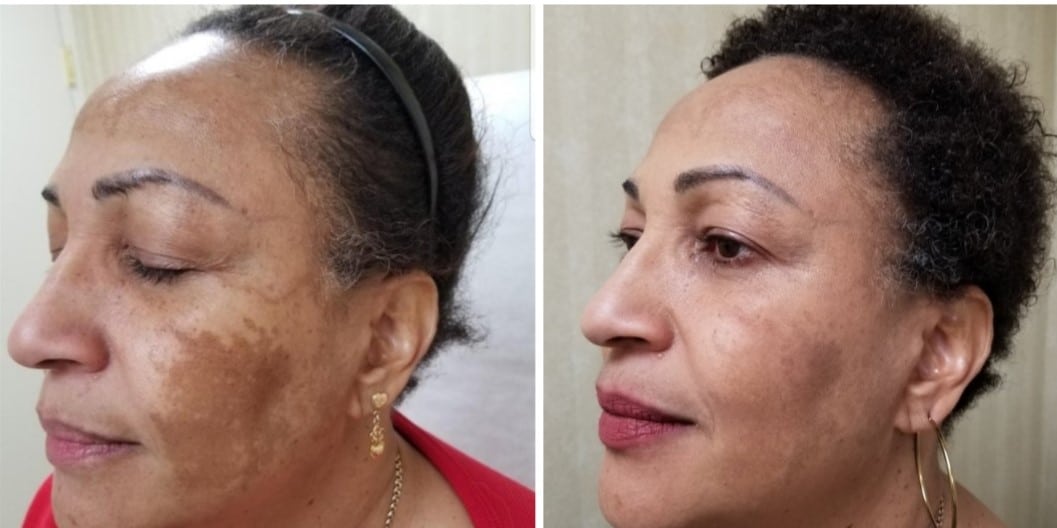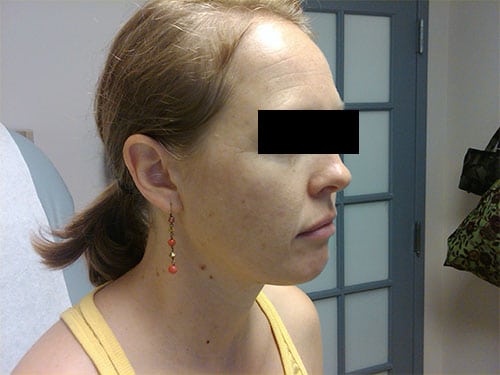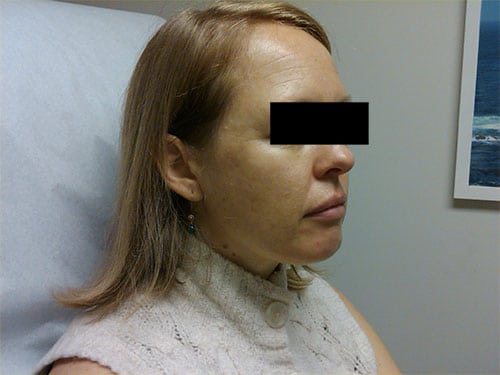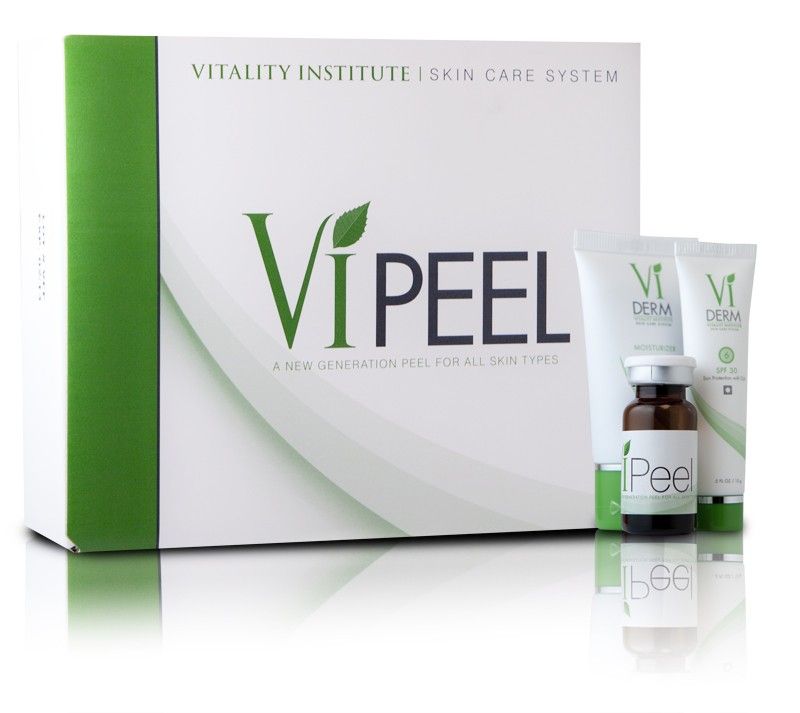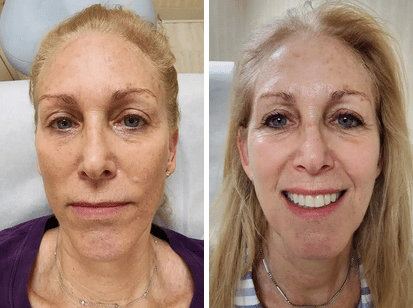Chemical peels NYC- Chemical peels are a tried-and-true strategy for beautifying and healing skin. At Aglow Dermatology we are highly experienced at doing chemical peels on patients of all skin types. Call 212-627-1004 today to schedule your chemical peel consultation with Dr. Strachan!
What are Chemical Peels NYC?
Chemical Peels are procedures during which a substance is applied to the skin resulting in faster skin cell turnover (exfoliation or peeling). They come in different strengths that penetrate to different depths of the skin. Chemical peels are one of the most popular dermatologic procedures.
Chemical Peel Benefits | Chemial peel near me
Chemical peels have a variety of benefits. Despite being effective, compared to many other treatments chemical peels tend to be fast and affordable. Even if one doesn’t have a specific skin problem, getting a chemical peel is a great way to restore and maintain a glowing complexion. Here are some of the problems a chemical peel can be helpful for:
- acne
- acne scars
- postinflammatory hyperpigmentation
- melasma
- actinic keratoses
- sun damage
- fine lines
- freckles
- razor bumps
- dull complexion
- warts
- keratosis pilaris
- dark armpits, groin and genitals
- acanthosis nigricans
Types of Chemical Peels
There are different types of chemical peels (superficial, medium, and deep) which offer different benefits and risks. Some peels include only one ingredient and some are blends of several peeling agents.
Superficial (Light) Peel:
- penetrates the epidermis (the most superficial layer of skin) causing dryness or mild peeling
- Conditions: acne, melasma, post-inflammatory hyperpigmenation, sun damage, fine lines, complexion management
- Examples: low concentration, glycolic acid, salicyclic acid, tretinoin, mandelic acid, lactic acid, low concentration TCA
Medium Peel:
- penetrates the epidermis and the upper (papillary) dermis causing significant peeling
- Conditions: acne, acne scars, post-inflammatory hyperpigmentation, sun damage, fine lines, actinic keratoses, complexion management
- Examples: high concentration glycolic acid, Jessner’s and modified Jessner’s. tricholoracetic acid (TCA) at low concentration, VI Peel
Deep Peel:
- penetrates deeper into the dermis causing peeling and crusting
- Conditions: severe scar and sun damage. Not generally safe in darker skin. Largely replaced by lasers.
- Examples: Phenol, Baker-Gordon, high concentration TCA
The deeper the peel, the more dramatic the changes but also the greater the recovery time and increased risk of complications and scars. Deeper peels may require pretreatment of the skin. It’s best to do the most superficial peel that will achieve the desired results.

Chemical Peels NYC – dermatologist for chemical peel
Glycolic Acid (Alpha Hydroxy Acid)One of our lighter peels. Glycolic acid peels are an excellent choice for acne, sun damage, fine lines, and hyperpigmentation. Preferred in patients who have aspirin allergy.
Salicylic Acid (Beta Hydroxy Acid)
Salicyclic acid peels are one of our most popular chemical peels for acne because salicyclic acid is attracted to the oil in the hair follicles where acne forms. The hyperpigmentation, sun damage, and fine lines but are slightly stronger.
Modified Jessner’s Peel
This slightly stronger peel gives dramatic results after even one peel. It is more effective for textural changes resulting from sun damage and acne scarring in addition to being an excellent choice for acne, fine lines, and discoloration. It is also a popular peel for acne scars.
VI Peel®
All the rage in Hollywood, the VI Peel is a custom blend of peeling agents that result in a glowing complexion within a week. The VI Peel is particularly effective in clearing hyperpigmentation quickly but is also very effective for acne, wrinkles, and sun damage. Samples of VI Derm professional skin care products come with peel. We also carry the Vi Peel for Body. Learn more here: Vi Peel NYC
A V.I.P. (very important peel) – The Vi Peel
VI Peel for body | chemical peel for body
The Vi Peel body treatment is a specially formulated Vi Peel designed for the thicker skin of the body. This peel requires a longer visit as there is a short wait period between applications of the peel. Like the traditional Vi Peel results are seen after even one peel but for some conditions three peels are recommended. Vi body comes with written instructions and a kit for post peel care. Check out our Vi peel body before and after here:


Enerpeel® EL System
This peel is designed to treat the delicate skin of the eyelids and around the lips resulting in increased skin firmness, decrease in fine lines and dark circles around the eyes. A series of 4 peels is recommended for best results however results may be seen after only one peel.
Trichloroacetic Acid Peel (TCA) | TCA peel near me
TCA peels come in different strengths. The medium depth peels can be excellent for the treatment of sun damage, actinic keratoses and depressed acne scars. TCA peels are safer in people with lighter colored skin. People with darker complexions may need to prep the skin with a bleaching cream for 2 to 3 weeks prior to treatment. This peel generally has a longer period of downtime (approximately 1 week) but it delivers more dramatic results.
TCA peel NYC - Chemical Peels Before and After
Chemical peel on body
Although doing a peel on the face and neck are most popular, chemical peels are also a great treatment for acne, rejuvenation, acanthosis nigricans, hyperpigmentation, and stretch marks on the body. Common locations include the hands, chest, back, arms, and legs. Chemical peels are also great choices for lightening intimate areas such as the armpits, inner thighs and genitals.
Most of the same peels used on the face can also be used on the body. We also, however, offer a special formulation of the Vi Peel called Vi Peel Body. This is a stronger formulation specifically designed for use on the body. Vi Body peels are a slightly longer procedure.
what is the BEST chemical peel near me?
The best chemical peel depends on the patient and their goals. If you are looking to do a chemical peels for acne, for example, it may be better to use salicylic acid as this dissolves in oil and targets the hair follicle. If you want to do chemical peels for acne scarring, a modified Jessner peel or TCA peel would be a better choice. When the chemical peel is for hyperpigmentation, we often use the Vi Peel. All the peels treat multiple problems. The best chemical peel will be determined by the condition of your skin, what you are treating, your tolerance for down time, and costs.
Are Chemical Peels safe?
When done on the right patient, by the right professional, chemical peels are a safe and effective strategy to address a variety of skin problems. All treatments, however, have risks. The risks increase the deeper the peel and the darker the patient’s skin. The potential side effect of chemical peels include peeling, infection, scar, discoloration, pain. Aftercare is also important in preventing complications.
Chemical Peels for Black Skin | Chemical peels for dark skin
Occasionally patients come in stating that they’ve been told that chemical peels should not be done on people with darker skin because of concerns about postinflammatory hyperpigmentation (PIH). This is misinformation. African American, Asian, Latino and other people with dark skin can benefit tremendously from chemical peels. In fact, these patients may benefit more from these treatments as chemical peels are often used to treat hyperpigmentation which is more common in darker skin. Yes, PIH is a concern, but dark-skinned patients can enjoy the benefits of peels when treated by someone experienced with ethnic skin.
What to do before a Chemical Peel
Avoid use of products containing retinoids, glycolic acid, and salicylic acid, as well as scrubs, microdermabrasion and waxing for 3 days before most chemical peels. Do not get a peel if you have a cold sore, rash, or infection on the area to be treated.
What happens during a Chemical Peel
The procedure usually takes no more than 20 minutes. After cleansing the face, or other area to be treated, a peeling agent is applied. There may be some skin stinging during this process. You will be given a fan for your comfort. Sometimes the skin flushes temporarily. Depending on which agent is used, it may be washed off or left on the skin. There is an application of moisturizer and sunscreen before you leave.
What to expect after a Chemical Peel
The peeling process usually begins 1-3 days after the procedure and is complete in 5-7 days. With lighter peels skin may show no visible peeling or may appear dry and flaky during the week after the peel. Some people also have some temporary redness. There may be significant peeling and crusting if a stronger peel was applied. You will be able to return to work or other activities immediately after your chemical peel, however there may be some social downtime usually starting on day 3 with stronger peels. Although it is best not to, make up can be applied right after a glycolic or salicylic acid peel, however, it should not be used right after a leave-on peel.
Chemical Peel After Care (General Guidelines)
- avoid direct sun, waxing, scrubbing, or picking at the skin
- avoid products and medications such as retinoids, glycolic acid or salicyclic acid for 1 week after
- wash with a gentle cleanser twice daily
- use a moisturizer with sunscreen daily
- use a plain moisturizer at bedtime
- moisturize the face
- report any unexpected side effects to your doctor

How often should you get Chemical Peels?
The number and frequency of chemical peels will depend on the condition being treated, the type of peel and what other treatments one is using. Sometimes it takes only one peel to achieve the results one is looking for. If more than one peels is required, most superficial and medium depth peels can be repeated in 2-4 weeks.
How long does it take to see results after Chemical Peel?
We see the results of most superficial and medium depth chemical peels generally 1 week after the peel. Deeper peels may require a month.
Are Chemical Peels Safe for Sensitive Skin?
Absolutely! Chemical peels can be a safe and effective option for individuals with sensitive skin when performed by an experienced dermatologist like Dr. Dina Strachan. She understands the unique needs of sensitive skin and tailors the treatment accordingly. Dr. Strachan uses gentle, yet effective, chemical peel solutions that minimize the risk of irritation or adverse reactions. With her expertise, you can trust that your sensitive skin will be in good hands, leaving you with a refreshed and rejuvenated complexion.
Can Chemical Peels Remove Freckles or Tattoos?
While chemical peels are not specifically designed to remove freckles or tattoos, they can help improve the appearance of certain pigmentation issues. Chemical peels work by exfoliating the top layers of the skin, which can reduce the visibility of freckles and uneven skin tone. However, it's important to note that completely removing freckles or tattoos may require other specialized treatments. Dr. Strachan can assess your unique situation and recommend the most suitable treatment options to address your specific concerns.
What is the Best Age to Start Getting Chemical Peels?
The ideal age to start getting chemical peels can vary depending on individual factors and skin conditions. Generally, individuals in their late twenties or early thirties may benefit from chemical peels as a preventative measure against signs of aging and to maintain a healthy, glowing complexion. However, it's never too late to start incorporating chemical peels into your skincare routine. Dr. Dina Strachan can assess your skin and recommend a personalized treatment plan tailored to your unique needs and goals. Her expertise in dermatology and understanding of different skin types and concerns make her the perfect choice for individuals of all ages who want to achieve their best skin and maintain their youthful appearance.
Do Chemical Peels Help with Clogged Pores?
Yes, chemical peels can be an excellent solution for addressing clogged pores. Clogged pores are often caused by a buildup of dead skin cells, excess oil, and debris, leading to acne breakouts and dull-looking skin. Chemical peels work by exfoliating the skin and deeply cleansing the pores, effectively removing impurities and promoting cellular turnover. Dr. Strachan offers a range of chemical peel options tailored to your specific skin concerns, helping to unclog pores, reduce acne, and restore a clearer, smoother complexion. The best part is that chemical peels typically have minimal social downtime, allowing you to return to your daily activities with little interruption. Dr. Strachan will also provide you with simple aftercare instructions to ensure optimal results and help you maintain your skin's newfound radiance. Book an appointment today to experience the benefits of chemical peels and regain your confidence in your skin.
How much do Chemical Peels cost?
Chemical peels at Aglow Dermatology generally range from $750-$200/peel depending on the type. In some cases patients with acne, melasma, post inflammatory hyperpigmentation, warts and actinic keratoses can get peels covered by insurance.
READ: Are chemical peels covered by insurance?
To see our before and after photos of chemical peels NYC, or chemical peel results, please visit our photo gallery page.
Schedule a Chemical Peel Consultation In NYC!
Chemical peels Manhattan- popular for patients of all skin types. Wondering which chemical peel is right for your? Are you ready for yours? Contact us for more information about the different types of chemical peels at 212-627-1004 or use our FORM.


